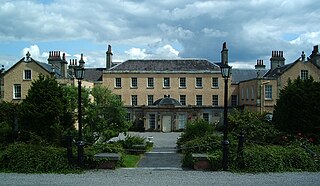
County Tipperary is a county in Ireland. It is in the province of Munster and the Southern Region. The county is named after the town of Tipperary, and was established in the early 13th century, shortly after the Norman invasion of Ireland. The population of the county was 159,553 at the 2016 census. The largest towns are Clonmel, Nenagh and Thurles.

Thurles is a town in County Tipperary, Ireland. It is located in the civil parish of the same name in the barony of Eliogarty and in the ecclesiastical parish of Thurles. The cathedral church of the Roman Catholic Archdiocese of Cashel and Emly is located in the town.

Cahir is a town in County Tipperary in Ireland. It is also a civil parish in the barony of Iffa and Offa West.

Clonmel is the county town and largest settlement of County Tipperary, Ireland. The town is noted in Irish history for its resistance to the Cromwellian army which sacked the towns of Drogheda and Wexford. With the exception of the townland of Suir Island, most of the borough is situated in the civil parish of "St Mary's" which is part of the ancient barony of Iffa and Offa East.

Ballyporeen is a village in County Tipperary, Ireland. The 2016 census recorded a village population of 318.

Carrick-on-Suir is a town in County Tipperary, Ireland. It lies on both banks of the River Suir. The part on the north bank of the Suir lies in the civil parish of "Carrick", in the historical barony of Iffa and Offa East. The part on the south bank lies in the civil parish of Kilmolerin in the barony of Upperthird, County Waterford.

Ardfinnan is a small village in County Tipperary in Ireland. It is situated on the River Suir and R665 regional road. The Catholic parish of Ardfinnan is made up of three areas: Ardfinnan, Ballybacon, and Grange. Ardfinnan is also a civil parish in the ancient barony of Iffa and Offa West. The village is located 14 kilometers from the town of Clonmel and six miles from Cahir via the R670 road. The population of the village is approximately 900 people.

Clogheen is a village in County Tipperary, Ireland. The census of 2016 recorded the population at 478 people.

John Philip Bagwell DL was an Irish businessman and politician.

Kilsheelan is a village and civil parish within the in the barony of Iffa and Offa East in County Tipperary, Ireland. It is also one half of the Roman Catholic parish of Kilsheelan & Kilcash in the Roman Catholic Diocese of Waterford and Lismore.

Ardfinnan GAA is a Tipperary GAA club which is located in County Tipperary, Ireland. The club, which competes at county level and in the "South" division of Tipperary GAA, is known by its supporters as "the village". The team's home ground is on the main Ardfinnan to Clonmel road just outside the village. The club draws its players and support from the village of Ardfinnan and the neighbouring parishes of Grange and Ballybacon.
Richard Bagwell was a noted historian of the Stuart and Tudor periods in Ireland, and a political commentator with strong Unionist convictions. He was the eldest son of John Bagwell, M.P. for Clonmel from 1857 to 1874. His son John Philip Bagwell followed the family tradition in politics becoming a Senator in the government of the Irish Free State in 1923.

Inislounaght Abbey, also referred to as Innislounaght, Inislounacht and De Surio, was a 12th-century Cistercian settlement on the river Suir, near Clonmel in County Tipperary, Ireland. It was originally dedicated to the Blessed Virgin.
William Bagwell was an Irish Tory politician who served for more than twenty years as a Member of Parliament (MP) in the United Kingdom House of Commons.

Marlfield House was the former residence of the Bagwells, a wealthy and politically influential Irish Unionist family in south Tipperary from the eighteenth to the twentieth centuries.
Ramsay Weston Phipps was an Irish-born military historian and officer in Queen Victoria's Royal Artillery. The son of Pownoll Phipps, an officer of the British East India Company's army, he was descended from the early settlers of the West Indies; many generations had served in the British, and the English military. Phipps served in the Crimean War, had a stint of duty at Malta, and helped to repress the Fenian uprising in Canada in 1866.

Knocklofty House is a sprawling county mansion that is situated near Clonmel in County Tipperary, Ireland. It previously operated as a hotel.
Marlfield Distillery was an Irish whiskey distillery which operated in the village of Marlfield, just outside of Clonmel, Ireland between approximately 1817 and 1856.
Lilla Minnie Perry was an Irish landscape painter.
Harriet Bagwell was an Irish philanthropist and promoter of local cottage industry.




















